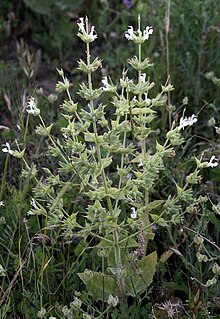Salvia macrosiphon
| Salvia macrosiphon | |
|---|---|

| |
| Scientific classification | |
| Kingdom: | Plantae |
| Clade: | Tracheophytes |
| Clade: | Angiosperms |
| Clade: | Eudicots |
| Clade: | Asterids |
| Order: | Lamiales |
| Family: | Lamiaceae |
| Genus: | Salvia |
| Species: | S. macrosiphon
|
| Binomial name | |
| Salvia macrosiphon | |
| Synonyms[1] | |
|
Salvia albifrons Nábelek | |
Salvia macrosiphon is a species of flowering plant in the mint family, Lamiaceae.[1][2] It is native to Iraq, Iran, Pakistan, Afghanistan, Transcaucasia, and Turkey, where it grows at the edges of fields. It is a perennial herb with a white corolla and ovate nutlets. It flowers in May and fruits from June onwards. Although the plant is similar to , it differs in that it has narrower leaves and calyces, is less indurate and has less spiny fruiting calyces, and possesses a longer corolla tube.[3]
References[]
- ^ a b "Salvia macrosiphon Boiss". Plants of the World Online. The Trustees of the Royal Botanic Gardens, Kew. n.d. Retrieved September 6, 2020.
- ^ "Salvia macrosiphon Boiss". World Flora Online. The World Flora Online Consortium. n.d. Retrieved September 6, 2020.
- ^ Kahraman, A.; F. Celep & M. Dogan (2009). "A New Record for the Flora of Turkey: Salvia macrosiphon Boiss. (Labiatae)". Turkish Journal of Botany. 33: 53–55.
Categories:
- Salvia
- Flora of Armenia
- Flora of Azerbaijan
- Flora of Georgia (country)
- Flora of Iraq
- Flora of Turkey
- Taxa named by Pierre Edmond Boissier
- Salvia stubs